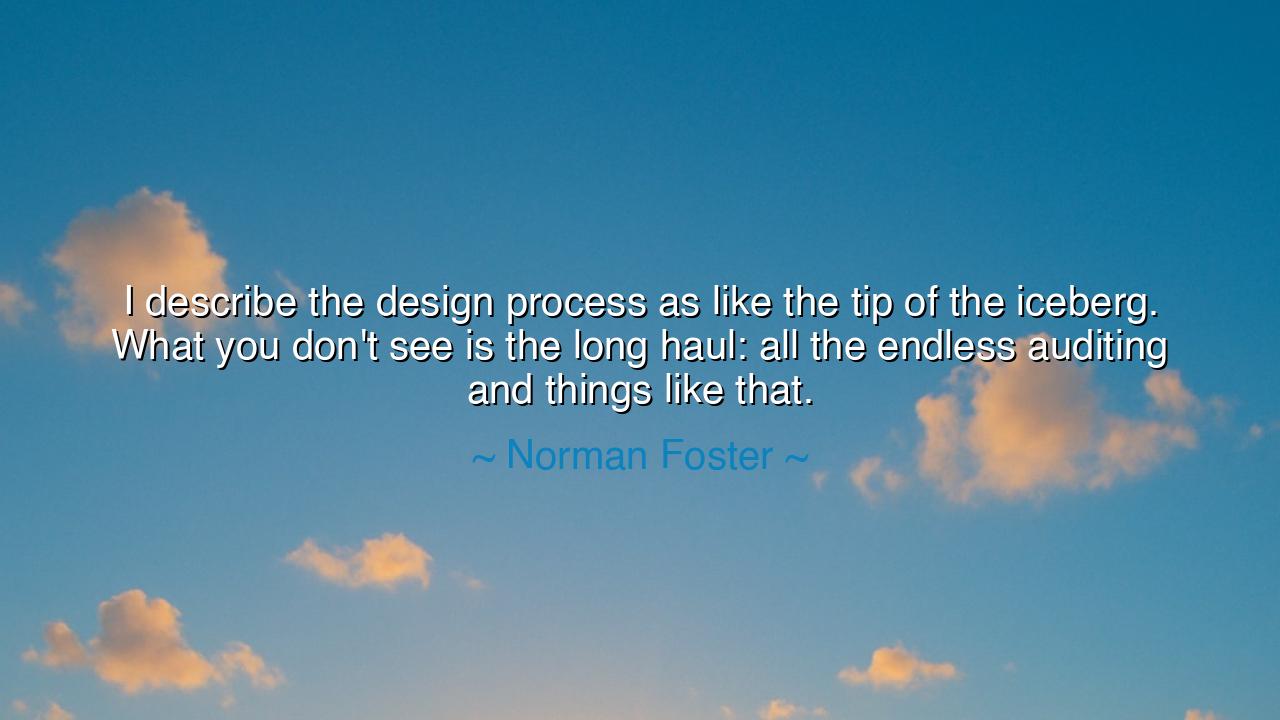
I describe the design process as like the tip of the iceberg.
I describe the design process as like the tip of the iceberg. What you don't see is the long haul: all the endless auditing and things like that.






Norman Foster, one of the great visionaries of modern architecture, once said: “I describe the design process as like the tip of the iceberg. What you don't see is the long haul: all the endless auditing and things like that.” In these words lies a profound truth about creation, discipline, and the hidden labor that underpins every act of brilliance. To the untrained eye, the completed work — whether a building, a painting, or an invention — seems effortless, almost magical. But Foster reminds us that beauty is not born in the flash of inspiration alone; it is forged in the unseen depths, in the long hours of analysis, refinement, and persistence that shape the invisible foundation beneath the visible form.
The meaning of this quote reaches far beyond architecture. The “tip of the iceberg” is that elegant moment of revelation, the finished design that captures admiration and wonder. But beneath it lies the mass of invisible effort — the endless calculations, revisions, and self-questioning that few will ever witness. It is in this submerged realm that true mastery is cultivated. Foster speaks not only of blueprints and audits, but of the spiritual labor of creation itself — the patience to perfect, the courage to persist, the humility to start again. His words are a reminder that what the world applauds in seconds has often taken years to prepare, and that the essence of greatness lies in what is done when no one is watching.
The origin of Foster’s insight comes from his own journey — a man who rose from humble beginnings in Manchester to become one of the most renowned architects of his time. His works — from the Millau Viaduct in France to the Reichstag Dome in Berlin — appear as though they were conceived in a moment of divine clarity. Yet each was the result of countless months of study, collaboration, and iteration. Every curve, every beam, every shaft of light was tested, recalibrated, and refined. Foster’s iceberg metaphor is not merely poetic; it is literal. The grandeur that the world sees in his architecture rests upon a mass of hidden structure — the human structure of endurance, intellect, and craft.
History, too, offers many reflections of this truth. Consider Michelangelo, who painted the Sistine Chapel ceiling lying upon scaffolds for four long years. The world sees only the radiant frescoes — the divine figures that seem to move with celestial life. Yet beneath the paint were thousands of preparatory sketches, anatomical studies, and sleepless nights of labor. When asked how he created such beauty, Michelangelo said, “If people knew how hard I worked, it wouldn’t seem so wonderful at all.” His words and Foster’s echo the same eternal wisdom — that invisible labor is the root of visible greatness.
Foster’s “long haul” also speaks to the virtue of discipline, a quality often forgotten in an age that glorifies speed. The creative process, like the construction of an iceberg, is slow, cumulative, and enduring. It demands faith in the unseen — the conviction that each small refinement, each quiet calculation, will one day give rise to something monumental. In architecture, as in life, what endures is not what is rushed, but what is built upon integrity and patience. The quick and shallow may shine for a season, but only the deeply anchored can withstand the tests of time.
There is also humility in Foster’s metaphor. He reminds us that the beauty of design — or any achievement — is never solely the result of genius, but of collaboration and meticulous preparation. Beneath the visible tip of the iceberg lies a network of minds and hands: engineers, planners, draftsmen, artisans. Just as the iceberg’s base sustains its peak, the unseen efforts of many sustain the brilliance of one. This truth humbles the ego and honors the collective nature of creation. No masterpiece stands alone; it is always the culmination of shared labor and invisible devotion.
The lesson of Foster’s wisdom is one of reverence for process. In a world that often celebrates outcomes, he calls us to cherish the unseen journey — the quiet diligence that precedes every triumph. Whether one is an artist, a scholar, or a builder of dreams, remember: the worth of your work is not measured by how swiftly it is admired, but by how deeply it is rooted. Tend to the foundations that no one sees — your discipline, your values, your perseverance — for these are the ice beneath your brilliance.
So, my children of creation, remember this ancient truth: what is seen is only a reflection of what is hidden. Do not envy the splendor of others’ peaks; instead, build your depths. Let your unseen labor be vast and unwavering, for from it will rise a work that stands unshaken amid the tempests of time. As Norman Foster teaches us, greatness is not found in the spark of inspiration, but in the long, silent haul beneath the surface — where the soul meets its craft, and endurance becomes art.






AAdministratorAdministrator
Welcome, honored guests. Please leave a comment, we will respond soon